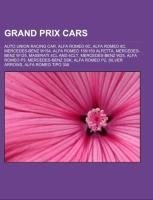
-
 Anglický jazyk
Anglický jazyk
Grand Prix cars
Autor: Source: Wikipedia
Source: Wikipedia. Pages: 31. Chapters: Auto Union racing car, Alfa Romeo 6C, Alfa Romeo 8C, Mercedes-Benz W154, Alfa Romeo 158/159 Alfetta, Mercedes-Benz W125, Maserati 4CL and 4CLT, Mercedes-Benz W25, Alfa Romeo P3, Mercedes-Benz SSK, Alfa Romeo P2, Silver... Viac o knihe
Na objednávku, dodanie 2-4 týždne
13.38 €
bežná cena: 15.20 €
O knihe
Source: Wikipedia. Pages: 31. Chapters: Auto Union racing car, Alfa Romeo 6C, Alfa Romeo 8C, Mercedes-Benz W154, Alfa Romeo 158/159 Alfetta, Mercedes-Benz W125, Maserati 4CL and 4CLT, Mercedes-Benz W25, Alfa Romeo P3, Mercedes-Benz SSK, Alfa Romeo P2, Silver Arrows, Alfa Romeo Tipo 308, Bugatti Type 13, Bugatti Type 35, Alfa Romeo Tipo 512, Maserati 26M, Alfa Romeo 12C, A.L.F.A. 40/60 GP, Bugatti Type 51, Alfa Romeo Tipo 316, Alfa Romeo Tipo A, Maserati 8C, Alfa Romeo Tipo 312, Alfa Romeo P1, Maserati 6CM, Bugatti Type 32, Maserati V8RI. Excerpt: The Auto Union Grand Prix racing cars types A to D, were developed and built by a specialist racing department of Horch works in Zwickau between 1933 and 1939. Between 1935 and 1937 Auto Union cars won 25 races, driven by Ernst von Delius, Tazio Nuvolari, Bernd Rosemeyer, Hans Stuck and Achille Varzi. Much has been written about the difficult handling characteristics of this car, but its tremendous power and acceleration were undeniable - a driver could induce wheelspin at over 100 mph (160 km/h). The cars throughout their production history were the main Grand Prix protagonists with Mercedes-Benz, particularly dominant in 1936. The dominance of the Silver Arrows of both brands was only stopped by the outbreak of World War II in 1939. Having been made redundant from Steyr Automobile, Dr. Ferdinand Porsche founded Porsche in Stuttgart, with engineering colleagues including Karl Rabe, and financial backing from Adolf Rosenberger. Unfortunately, car commissions were low in the depressed economic climate, so Porsche founded a subsidiary company Hochleistungs Motor GmbH (High Efficiency Engines Ltd.) in 1932 to develop a racing car, for which he had no customer. In 1933, Grand Prix racing was dominated by French and Italian marques Bugatti, Alfa Romeo and Maserati. In early 1933, governing body AIACR announced a new formula, with the main regulation meant that the weight of the car without driver, fuel, oil, water and tyre was not allowed to exceed 750 kg (1,700 lb). This was created to restrict the size of engine that could be used, with the authority estimating that this weight limit would allow around 2.5 litre engines. Based on Max Wagner's mid-engined 1923 Benz Tropfenwagen, or "Teardrop" aerodynamic design, also built in part by Rumpler engineers, the experimental P-Wagen project racing car (P stood for Porsche) was designed according to the regulations of the 750 kg formula. On November 15 chief engineer Rabe submitted the first draft to the planning office of a r
- Vydavateľstvo: Books LLC, Reference Series
- Rok vydania: 2012
- Formát: Paperback
- Rozmer: 246 x 189 mm
- Jazyk: Anglický jazyk
- ISBN: 9781155532905


 Nemecký jazyk
Nemecký jazyk 








